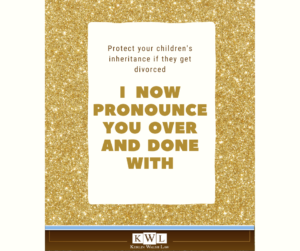Clients frequently come to Kerlin Walsh Law to make a plan for beneficiaries of their retirement accounts. But did you know that most people are shocked to learn that their retirement accounts can be seized once the accounts are passed to their loved ones?
During your client’s lifetime, their retirement funds have fairly comprehensive asset protection, meaning they cannot be taken in a lawsuit. Unfortunately, as soon as retirement accounts are inherited, the protection evaporates in most states. This means their hard-earned money can legally be snatched by their beneficiaries’ creditors and the courts.
As your client’s advisor, you can look for ways during meetings to protect your clients and their loved ones, as well as their money and property. Discuss their retirement accounts so that together you can determine whether a retirement trust would make sense for your client.
What Is a Standalone Retirement Trust and Why Might It Be Good for Your Client?
A standalone retirement trust (SRT) is a special type of trust designed to be the beneficiary of your client’s qualified retirement accounts such as IRAs, 401(k)s, etc. During your client’s lifetime, ownership of and access to the accounts do not change. Upon your client’s death, as long as he or she has properly named the SRT as the beneficiary on the appropriate beneficiary designation form, the trust will become the beneficiary, and the trustee of the trust will be in charge of withdrawing and managing the money received from the inherited retirement account according to the terms laid out in the trust document.
A review of records can determine whether an SRT would be right for your client. The SRT is a popular planning tool because it:
- protects inherited retirement accounts from beneficiaries’ creditors as well as predators and lawsuits
- ensures retirement accounts go to whom you designate—and nobody else
- allows for experienced management and oversight of funds by a professional trustee
- protects beneficiaries from reckless spending
- enables proper planning for a special needs beneficiary
- permits your client to name minor beneficiaries as immediate beneficiaries without court-supervised guardianship
- facilitates generation-skipping transfer tax planning
Divorce Creditor—A Common Example
Many parents are concerned that their in-laws may someday become the outlaws—that is, that their children may someday get divorced, and their children’s inherited money and property will be seized by a divorcing spouse.
Here is the story of Mary and John. Which outcome would you prefer for your client’s children?

Option 1: Mary and John love their son-in-law, Mike, and think his marriage to their daughter Liz will last. They gave Liz her share of their retirement plans outright at their deaths. Five years later, Liz and Mike divorced and Mike was able to take 50 percent of Liz’s inherited retirement funds.
Option 2: Mary and John love their son-in-law, Mike, but recognize that 50 percent of all marriages end in divorce. It is an unfortunate reality, so when they did their estate planning, they provided for their children but made sure the inheritances could not be taken from them. Instead of outright distributions, they passed their retirement plans in trust. Five years later, Liz and Mike divorced, and Mike was not able to take any of Liz’s inheritance. Liz was able to use the funds in the trust to create a new beginning.
If Your Client Already Has an SRT, Now Is the Time to Review It
 However, because the SECURE Act did away with the lifetime stretch for most beneficiaries (with some exceptions), the conduit provisions may cause some unintended consequences. Most beneficiaries are required to withdraw the entire balance of the inherited retirement account by the end of the tenth year following the plan participant’s death. Therefore, a trust with conduit provisions requires the trustee to give the entire account balance to the trust beneficiary within ten years of the account owner’s death, unless the beneficiary is an eligible designated beneficiary. While this means that your client’s ultimate beneficiary cannot cash out the inherited retirement account immediately, the entire balance will be given to the beneficiary in about ten years after your client’s death. If ten years is too soon for your beneficiary, it may be wise to consider changing the SRT to include accumulation provisions instead. With accumulation provisions, the trustee can take any required distributions from the inherited retirement account and continue to hold them in a protected trust account for the beneficiary, making distributions according to the instructions provided in the trust.
However, because the SECURE Act did away with the lifetime stretch for most beneficiaries (with some exceptions), the conduit provisions may cause some unintended consequences. Most beneficiaries are required to withdraw the entire balance of the inherited retirement account by the end of the tenth year following the plan participant’s death. Therefore, a trust with conduit provisions requires the trustee to give the entire account balance to the trust beneficiary within ten years of the account owner’s death, unless the beneficiary is an eligible designated beneficiary. While this means that your client’s ultimate beneficiary cannot cash out the inherited retirement account immediately, the entire balance will be given to the beneficiary in about ten years after your client’s death. If ten years is too soon for your beneficiary, it may be wise to consider changing the SRT to include accumulation provisions instead. With accumulation provisions, the trustee can take any required distributions from the inherited retirement account and continue to hold them in a protected trust account for the beneficiary, making distributions according to the instructions provided in the trust.
Do you have questions or want to know more about protecting your client’s retirement accounts? While every situation is different, we can help you determine if an SRT is right for your client.
Contact us to schedule a conversation. We are available for in-person and virtual appointments. 708-448-5169 or Eileen@KerlinWalshLaw.com

